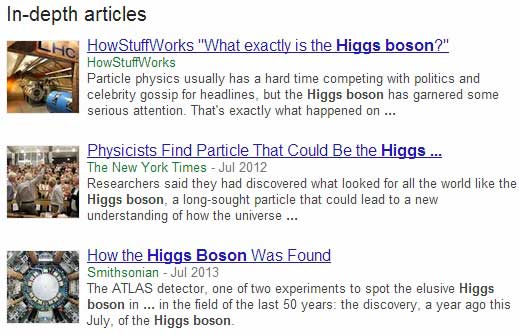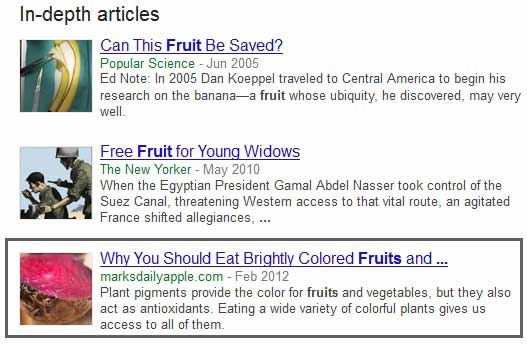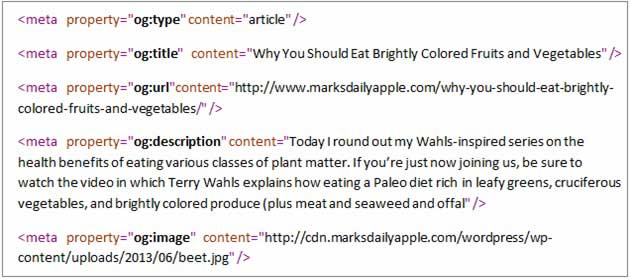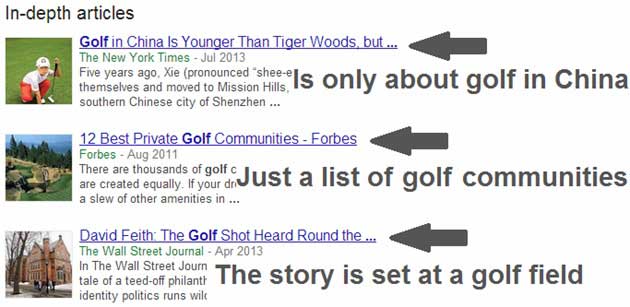Google recently introduced a search results section dubbed In-depth articles. The new type of listing was added after Google discovered that roughly 10% of users needed to look up information on a broad topic every day.
As the name implies, the in-depth articles search-results box consists of posts that provide exhaustive information on a subject, likely sparing one the need to look for additional material.
For example, let's say I'd like to know what Higgs boson is. Here are the three in-depth articles Google returned in response to my query:

So does the just-added search results section present new opportunities to content marketers? If your content strategy involves creating in-depth, timeless content on certain topics, read on... This article is for you.
How Google Picks In-Depth Articles
How does Google choose which post is worthy of in-depth status? A joint study by Denis Pinsky and Dr. Peter J. Meyer revealed some answers...
First, over 60% of all in-depth articles are by the following top 10 publishers:
- nytimes.com—25.3%
- wsj.com—8.0%
- newyorker.com—5.7%
- theatlantic.com—5.6%
- wired.com—4.2%
- slate.com—3.9%
- businessweek.com—3.7%
- thedailybeast.com—3.3%
- forbes.com—2.8%
- nymag.com—2.7%
Second, over 70% of all in-depth articles were published between 2011 and 2013:
- 2011—20.2%
- 2012—29.0%
- 2013—21.5%
Third, the top 10 categories that have the biggest percentage of in-depth article results are the following:
- 14.4%—Family & Community
- 12.8%—Health
- 12.0%—Law & Government
- 7.2%—Arts & Entertainment
- 7.0%—Finance
- 5.8%—Jobs & Education
- 5.6%—Hobbies & Leisure
- 4.8%—Computers & Consumer Electronics
- 4.4%—Internet & Telecom
- 3.6%—Food & Groceries
As you can see, most in-depth articles come from reputable, well-established resources (mostly from offline publications with online versions). Plus, they normally have a recent publication date and tend to fall into certain categories.
So does that mean smaller content publishers stand little chance of getting in on the action?
- First, Google created a guide on how one can increase the odds of being cited among In-depth articles. Clearly, Google would like more content creators to contribute comprehensive posts that could be used for the new section.
- Second, as you'll see from the case study I'm about to describe, a smaller publisher can realistically hit the in-depth section if the site is an authority in a niche and if the article meets the criteria in the above-mentioned Google guide.
The Anatomy of a Perfect In-Depth Article
If you search for "fruit" on Google, one of the results you get in the in-depth section is not a multipage piece by the New York Times. It's a post by Mark Sisson, who runs Mark's Daily Apple, a highly targeted niche blog that specializes in health and diet:

Upon closer look, it turns out...
- The post in question is 1,830 words long.
- The keyword ("fruit") is mentioned in its title and description.
- The keyword is also used eight times in the post's body, plus there are links to relevant posts at the end of it that contain "fruit" in the anchor texts.
- The article has 136 comments, 133 tweets, 241 Facebook shares, 8 Google +1s, and 12 StumbleUpon citations.
- The page has no Google authorship set up via the rel="author" attribute, but it does contain a link to Mark's Google+ profile.
- As for the use of structured data, no Google-recommended Schema.org markup is found, but there is a piece of code in the OpenGraph format that is analogous to Schema:

So, in many ways, the article is indeed compliant with Google's standards for in-depth articles, which include the following five items.
1. Using Schema.org markup for articles
Google recommends you to add a piece of code to the article that marks its...
- Headline
- AlternativeHeadline
- Image (note: the image must be crawlable and indexable)
- Description
- DatePublished
- ArticleBody
For ready-made templates, check out Schema.org/Article.
2. Adding Google Authorship
For Google to easily associate your article with its author, set up Google authorship for the content you create. Google authorship will not only make your article more authoritative but also help your content stand out in the search results.

3. Using pagination (if applicable)
If your piece of content is spread across multiple pages, use pagination to let Google know that these pages are part of one article. Google's Maile Ohye explains it all quite well:
4. Adding your logo
Another thing you can do to help your post be selected for the in-depth section is specify your company's logo. This can be achieved in two ways:
5. Letting Google index restricted content
If you offer content on a paid basis, that could prevent Google from indexing your site's pages in full, which in turn may lead to your most prominent content's being absent from the in-depth section.
To be able to stick to your subscription-based model and to still allow Google to crawl your content in its entirety, consider implementing First Click Free on your site.
The 'Evergreen' Content Optimization Checklist
So, how can you effectively prepare your content for inclusion into Google's in-depth articles section?
- From your target keywords, pick those that trigger the In-depth articles box.
- Think of their closely related variants, since similar words may return different listings (e.g., wine and red wine generate different sets of in-depth posts).
- Take note of queries that produce in-depth results from less authoritative sources; those could be easier to compete against.
- Create a lengthy and well-researched article on the topic.
- Optimize its title, description, and first paragraph for your keywords, but use just as many of them as you'd use naturally.
- Follow Google's recommendations on marking up the critical details about your in-depth article.
- Share the post with as many people on social media as you can.
- Allow comments, but make them pre-moderated to prevent spam.
- If your marketing strategy includes content syndication, pitch your piece of content to a higher-profile media resource you have ties with.
Criticism of Google's In-Depth Articles
Since Google launched the feature, in-depth articles have been facing criticism for lack of relevance and focus. For example, when I search for "golf," I get three "in-depth" listings none of which is talking about the general concept of the game:

Poor relevance could be attributed partly to Google's heavy reliance on well-known publications to provide results for the new search results, and partly to the lack of in-depth posts on a Web that's dominated by 300-word write-ups.
At the same time, Google did promise to start including "great articles from lesser-known publications and blogs" along with articles by "well-known publishers." Accordingly, the relevance of listings may soon improve, once Google hones the algorithm and when there is more content to include.
Conclusion
Because they show up on the first page of search results, recently launched Google's In-depth articles are well worth checking out. If you produce well-researched articles that are not going to get outdated in several months, consider optimizing them for the new Google results block.
And, even though one currently sees mostly big players like Forbes and Wired there, lesser-known publishers do stand a chance, provided they follow Google's guidelines for the new type of articles and create content that is popular with readers.




